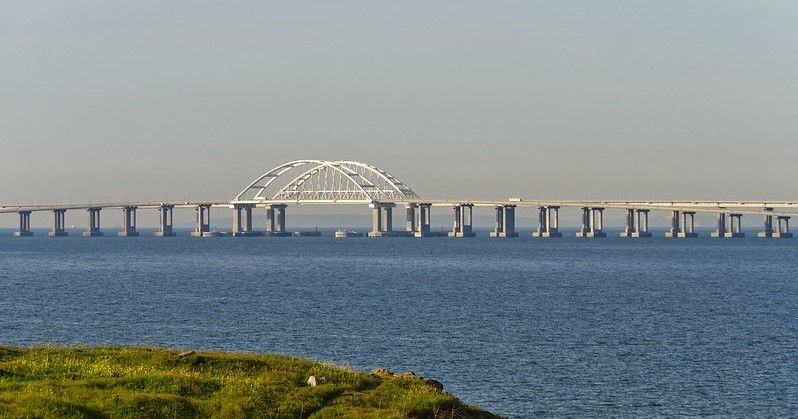Ukraine’s Use of Naval Drones is Reinventing Combat at Sea
Multiple successful attacks by surface drones are forcing Russia’s conventional and superior navy into retreat.

Russian naval operations in the Black Sea are being impeded by Ukraine's deployment of aerial drones and robot boats – a strategy which is rewriting the rules of war for maritime chokepoints.
Ultimately, the move toward uncrewed surface drones was borne from necessity. A deep strategic rethink after the 2014 seizure of a substantial portion of Kyiv's fleet along with the loss of its naval headquarters at Sevastopol following Russia’s annexation of Crimea.

So, when the full-scale invasion began in February 2022, the Ukrainian Navy had essentially already been rendered obsolete.
However, rather than surrendering complete control of the Black Sea and its vital sea lanes, Ukraine’s naval commanders adjusted their plans to rely increasingly on alternative hardware.
This means that Unmanned aerial vehicles (UAVs) and surface vessels (USVs) have frequently been combined with missiles to overwhelm Russian defences. A strategy which has announced a new era in asymmetrical maritime warfare.
The first evidence of the tactic was made in October 2022 with the Ukrainian attack on Russia's main naval station in Sevastopol by seven USVs and nine UAVs on the frigate Admiral Makarov and the minesweeper Ivan Golubets. Although neither ship was lost, both were severely damaged in the action proving how effectively and inexpensively Ukraine could still bring the war to the Russians despite maintaining no warships of note.

Once considered unusual, these coordinated drone attacks have now become the norm. Even considering Russia's efforts to strengthen its defences against drone threats, several Black Sea Fleet ships have been hit by Ukrainian strikes. For example, on February 14, the landing craft Caesar Kunikov was sunk by Magura V5 USVs. A few weeks later, the patrol boat Sergey Kotov was destroyed by five drones of the same type, in a combined operation between the Navy and the Intelligence Directorate.
All told, approximately one-third of the Black Sea Fleet's ships are believed to have been destroyed by Ukrainian missile and drone attacks - a severe blow to Russia. This is even more notable given Moscow’s heavy investment in the fleet over the past decade which added frigates, missile boats, and submarines all of which have now been forced away from the coast, opening up trade routes for goods from Ukraine.
You might also like to read: Beyond Reconnaissance: Navy Plans for Future Surface Drones or Counter-Drone Capability Heads to Sea
Since the war began, both technology and tactics have constantly been changing, evident in a night-time raid conducted on January 31, when USV operators sank the corvette Ivanovets, despite the vessel’s extensive manoeuvres and considerable naval fire. With remarkable precision, the USVs targeted certain portions of the ship to maximize damage.
However, not only have Ukrainian drones targeted ships, but they have also damaged important Russian infrastructure, such as the July 2023 attack by a Sea Baby USV on the Kerch Bridge which links Russia and Crimea.

Such attacks have shocked defence analysts by showing the audacity of the Ukrainian naval commanders and the versatility of drone technology. As the industry journal Defense One reports, “During their attacks, Ukraine's drone forces carefully monitor Russia's defensive efforts, including footage of Russian fighter jets and helicopters attempting to destroy the incoming drones from the air.” Noting that, “In the future, Ukrainian USVs might shoot back – in May, Ukraine showed off a new USV outfitted with two R-73 air-to-air missiles. Ukrainian designers have also toyed with installing tubes to fire Grad rockets, which would enable USVs to bombard positions at a distance.”
These controversial strategies and the shifting dynamics taking place in the Black Sea have military commanders considering their potential impact on other contended waterways, such as in the South China Sea, the Red Sea, and the Persian Gulf. By denying naval space to a far larger adversary, as Ukraine has done, the rule book for naval combat is being re-written.
While Russia may be able to identify and neutralize Ukrainian USVs by using its own surface drones, this in turn will merely start a new level of warfare conducted solely by non-human adversaries. A field where it is likely that Ukraine has the technological upper hand.

But the Black Sea is not the only place where naval warfare is adapting. Drone swarms are quickly turning into a major problem for contemporary fleets, as Houthi drone operators have carried out successful USV strikes off the coast of Yemen despite the presence of some of the most advanced warships and naval defences in the world.
Although the conflict in the Black Sea is far from over, it has already attracted international attention and gained Russian recognition. After 2014, the Ukrainian Navy was obliged by years of chronic underfunding to adopt a limited ‘mosquito fleet’ strategy, with a force built almost entirely around patrol boats. These vessels were incapable of deterring Russia’s larger warships which had planned to blockade and even attack Ukraine’s major export hub in Odessa.
The war in Ukraine has taught defence manufacturers much about how to integrate low-cost technology into military machines that can out-gun or out-think more expensive hardware. The move to surface drone raids and the application of drone swarms has proven to be a turning point in the development of future naval power.
Photo credit: Wikimedia, Auto.goodfon, Flickr, Wikimedia, & Picryl

